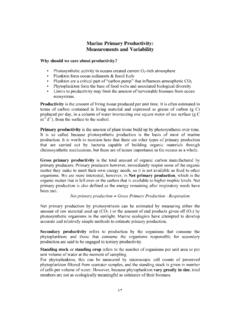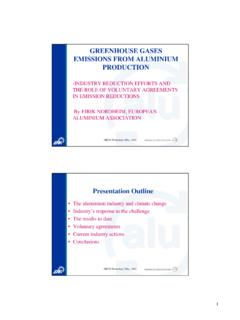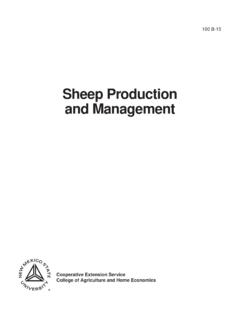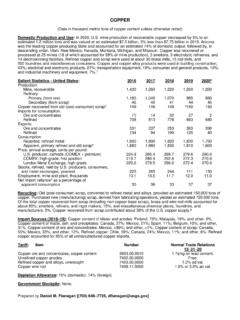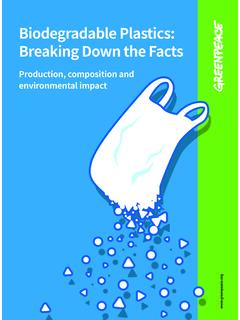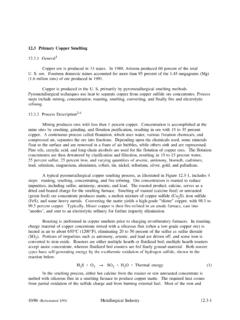Transcription of Chapter 6 Primary Production, Cycling of Nutrients ...
1 Chapter 6. Primary production , Cycling of Nutrients , Surface Layer and Plankton Writing team: Thomas Malone (Convenor), Maurizio Azzaro, Antonio Bode, Euan Brown, Robert Duce, Dan Kamykowski, Sung Ho Kang, Yin Kedong, Michael Thorndyke, and Jinhui Wang, Chul Park (Lead member); Hilconida Calumpong and Peyman Eghtesadi (Co-Lead members) 1. Primary Production1 Definition and ecological significance Gross Primary production (GPP) is the rate at which photosynthetic plants and bacteria use sunlight to convert carbon dioxide (CO2) and water to the high-energy organic carbon compounds used to fuel growth. Free oxygen (O2) is released during the process. Net Primary production (NPP) is GPP less the respiratory release of CO2 by photosynthetic organisms, , the net photosynthetic fixation of inorganic carbon into autotrophic biomass.
2 NPP supports most life on Earth; it fuels global cycles of carbon, nitrogen, phosphorus and other Nutrients and is an important parameter of atmospheric CO2 and O2 levels (and, therefore, of anthropogenic climate change). Global NPP is estimated to be ~105 Pg C yr-1, about half of which is by marine plants (Field et al., 1998; Falkowski and Raven, 1997; Westberry et al., 2008).2 Within the euphotic zone of the upper ocean,3 phytoplankton and macrophytes4 respectively account for ~94 per cent (~50 28 Pg C yr-1) and ~6 per cent (~ Pg C yr-1) of NPP (Falkowski et al., 2004; Duarte et al., 2005; Carr et al., 2006; Schneider et al., 2008; Chavez et al., 2011; Ma et al.)
3 , 2014; Rousseaux and Gregg, 2014). All NPP is not equal in terms of its fate. Marine macrophytes play an important role as carbon sinks in the global carbon cycle, provide habitat for a diversity of animal species, and food for marine and terrestrial consumers (Smith, 1981; Twilley et al., 1992; Duarte et al., 2005; Duarte et al., 2010; Heck et al., 2008; Nellemann et al., 2009; McLeod et al., 2011, Fourqurean et al., 2012). Phytoplankton NPP fuels the marine food webs upon which marine fisheries depend (Pauly and Christensen, 1995; Chassot et al., 2010) and the 1 Microbenthic, epiphytic and symbiotic algae can be locally important in shallow waters and corals, but are not addressed here.
4 Chemosynthetic Primary production is addressed elsewhere. 2 1 Pg = 1015 g 3 Defined here to include the epipelagic (0-200 m) and mesopelagic (200 -1000 m) zones. The euphotic zone lies within the epipelagic zone. 4 Macrophytes include sea grasses, macroalgae, salt marsh plants and mangroves. Phytoplankton are single -celled, photosynthetic prokaryotic and eukaryotic microorganisms growing in the euphotic zone (the layer between the ocean s surface and the depth at which photosynthetically active radiation [PAR] is 1 per cent of surface intensity). Most phytoplankton species are > 1 m and < 1 mm in equivalent spherical diameter (cf. Ward et al., 2012). 2016 United Nations 1 biological pump which transports 2-12 Pg C yr-1 of organic carbon to the deep sea (Falkowski et al.)
5 , 1998; Muller-Karger et al., 2005; Emerson and Hedges, 2008; Doney, 2010; Passow and Carlson, 2012), where it is sequestered from the atmospheric pool of carbon for 200-1500 years (Craig, 1957; Schlitzer et al., 2003; Primeau and Holzer, 2006; Buesseler, et al., 2007). Changes in the size structure of phytoplankton communities influence the fate of NPP (Malone, 1980; Legendre and Rassoulzadegan, 1996; Pomeroy et al., 2007; Mara n, 2009). In general, small cells (picophytoplankton with equivalent spherical diameters < 2 m) account for most NPP in subtropical, oligotrophic (< mg chlorophyll-a m-3), nutrient-poor (nitrate + nitrite < 1 M), warm (> 20 C) waters. Under these conditions, the flow of organic carbon to harvestable fisheries and the biological pump are relatively small.
6 In contrast, larger cells (microphytoplankton > 20 m) account for > 90 per cent of NPP in more eutrophic (> 5 mg chlorophyll-a m-3), nutrient-rich (nitrate + nitrite >10 M), cold (< 15 C) waters (Kamykowski, 1987; Agawin et al., 2000; Buitenhuis et al., 2012). Under these conditions, diatoms5 account for most NPP during spring blooms at high latitudes and periods of coastal upwelling when NPP is high and Nutrients are not limiting (Malone, 1980). The flow of organic carbon to fisheries and the biological pump is higher when larger cells account for most NPP (Laws et al., 2000; Finkel et al., 2010). Methods of measuring net Primary production (NPP) Phytoplankton Net Primary production Phytoplankton (NPP) has been estimated using a variety of in situ and remote sensing methods (Platt and Sathyendranath, 1993; Geider et al.)
7 , 2001; Marra, 2002; Carr et al., 2006; Vernet and Smith, 2007; Cullen, 2008a; Cloern et al., 2013). Multiplatform ( , ships, moorings, drifters, gliders, aircraft, and satellites) sampling strategies that utilize both approaches are needed to effectively detect changes in NPP on ecosystem to global scales (UNESCO-IOC, 2012). On small spatial and temporal scales (meters-kilometres, hours-days), several techniques have been used including oxygen production and the incorporation of 13C and 14C labelled bicarbonate (Cullen, 2008a). The most widely used and standard method against which other methods are compared or calibrated is based on the incorporation of 14C-bicarbonate into phytoplankton biomass (Steeman-Nielsen, 1963; Marra, 1995; Marra, 2002; Vernet and Smith, 2007; Cullen, 2008a).
8 On large spatial scales (Large Marine Ecosystems6 to the global ocean), the most effective way to detect space-time variability is via satellite-based measurements of water-leaving radiance combined with diagnostic models of depth-integrated NPP as a function of depth-5 Diatom growth accounts for roughly half of marine NPP and therefore for about a quarter of global photosynthetic production (Smetacek, 1999). 6 Large marine ecosystems (200,000 km2 or larger) are coastal ecosystems characterized by their distinct bathymetry, hydrography, productivity and food webs (Sherman et al., 1993). 2016 United Nations 2 integrated chlorophyll-a concentration ( Chl), photosynthetically active solar radiation, and temperature (Antoine and Morel, 1996; Perry, 1986; Morel and Berthon, 1989; Platt and Sathyendranath, 1993; Behrenfeld and Falkowski, 1997; Sathyendranath, 2000; Gregg et al.)
9 , 2003; Behrenfeld et al., 2006; Carr et al., 2006; Arrigo et al., 2008; Bissinger et al., 2008; McClain, 2009; Westberry et al., 2008; Cullen et al., 2012; Siegel et al., 2013). An overview of the latest satellite based models may be found at the Ocean Productivity Satellite ocean-colour radiometry (OCR) data have been used to estimate surface chlorophyll-a fields and NPP since the Coastal Zone Color Scanner (CZCS) mission (1978-1986). Uninterrupted OCR measurements began with the Sea-viewing Wide Field-of-view Sensor (SeaWiFS) mission (1997-2010) (Hu et al., 2012). A full accounting of current polar orbiting and geostationary ocean-colour sensors with their capabilities (swath width, spatial resolution, spectral coverage) can be found on the web site of the International Ocean-Colour Coordinating The skill of model-based estimates of NPP has been improving (O Reilly et al.
10 , 1998; Lee, 2006; Friedrichs et al., 2009; Saba et al., 2010; Saba et al., 2011; Mustapha et al., 2012), but further improvements are needed through more accurate estimates of Chl. Chlorophyll-a fields can be estimated more accurately by blending data from remote sensing and in situ measurements, especially in regions where in situ measurements are sparse and in turbid, coastal ecosystems (Conkright and Gregg, 2003; Gregg et al., 2003; Onabid, 2011). An empirical approach has been developed for ocean-colour remote sensing called Empirical Satellite Radiance-In situ Data (ESRID) algorithm (Gregg et al., 2009). Macrophyte Net Primary production The NPP of macroalgae, sea grasses, salt marsh plants and mangroves can be estimated by sequentially ( , monthly during the growing season) measuring increases in biomass (including leaf litter in salt marshes and mangrove forests) using a combination of in situ techniques ( , Mann, 1972; Cousens, 1984; Dame and Kenny, 1986; Amarasinghe and Balasubramaniam, 1992; Long et al.










